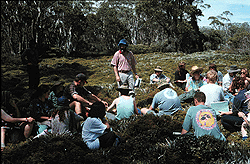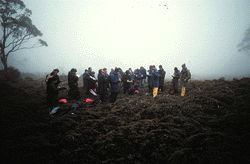|
|
Ecological factors:
| Soil: |
Deep uniform yellow vorwn, very stony clay loam in woodland, abruptly
grading to deep, dark brown to black peat. |
| Aspect: |
North-west, 315 degrees. |
| Slope: |
5 degrees. |
| Rainfall: |
2030mm |
| Vegetation type: |
Eucalyptus
coccifera / Eucalyptus
subcrenulata woodland with abrupt boundary to Astelia
alpina / Gleichenia
alpina closed - herbland (see top left photo). |
| Geology: |
Dolerite. |
Vegetation Structure
- Boundary between open woodland and moorland
- Open E. coccifera / E. subcrenulata woodland, 10-15m in
height, <40% cover
- Understorey of shrubs to 1.5m composed of Bauera rubioides and Richea
scoparia.
- Moorlands consist of emergent shrubs of Leptospermum rupestre, Epacris
serpyllifolia, Boronia citriodora.
- Groundcover >95% consisting of Gleichenia alpina and Astelia
alpina.
Vegetation Processes
- Factors causing abrupt boundary include;
- frost and cold air drainage
- Fire frequency
- Drainage and edaphic factors.
|



